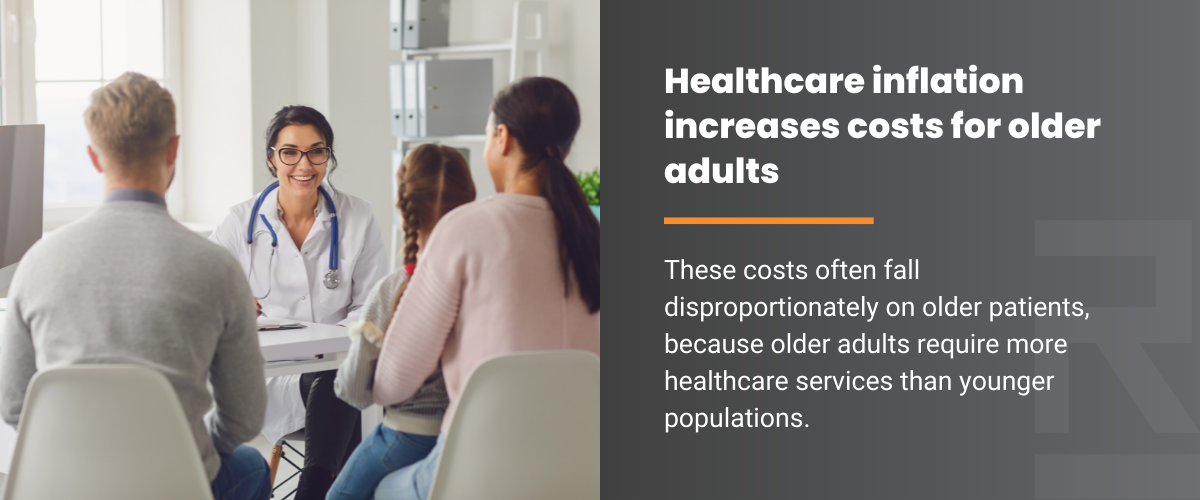For the past year, consumers and businesses have watched inflation grow to a record-breaking 8.6% at the end of May 2022, as reported by the U.S. Bureau of Labor Statistics. This is dramatically higher than the 0.7% to 2.3%, which consumers saw between 2012 and 2020.
Inflation is impacting healthcare organizations and clinics in multiple ways, including staffing, recruitment, revenue cycle management, and patient care decisions. But the right technology and tools can provide clinics with several innovative ways to combat these inflationary challenges and continue to thrive.
Inflation’s Impact on Household Spending
When inflation rises significantly, especially in such a short period of time, it has an impact on consumer attitudes and behaviors. In recently published research from Ipsos, consumers said they are feeling price increases most in:
- Grocery bills (75%)
- Gasoline (74%)
- Meat and dairy products (73%)
- Fresh fruits and vegetables (66%)
- Food at restaurants (63%)
Additionally, 80% of people surveyed said they plan to change their shopping habits if the high prices continue. They will seek lower-cost alternatives, look for promotions and sales, or purchase fewer items overall.
The same instinct to cut back is likely to carry over into consumer behaviors for healthcare services. Cost increases related to inflation could put some people at risk of missing out on essential care. These risks will show up in several ways:

Healthcare Inflation Increases Costs for Older Adults
Inflation is impacting the total cost of healthcare services. Medical care is one of eight groups in the Consumer Price Index (CPI) calculation for total inflation rates. Rising hospital prices were a major source of inflation early in 2022, according to the BLS.
These costs often fall disproportionately on older patients, because older adults require more healthcare services than younger populations.
Patients with private health insurance plans will also feel the squeeze. However, premium increases may not hit for another year as plans adjust rates to higher costs in 2022. For employer-sponsored plans (which cover about 55% of adults in the U.S.), higher costs are often passed along to members as higher deductibles or higher out-of-pocket maximums.
Patients Opting Out of Elective Surgery
In a survey from the University of Michigan Institute for Healthcare Policy and Innovation, 46% of respondents said that out-of-pocket costs were a significant concern when considering whether or not to get elective surgery.
Elective procedures already took a hit during the COVID pandemic, when millions of patients opted out of these surgeries. One study by the American College of Surgeons found that these missed elective procedures caused significant financial losses for hospitals. One university healthcare system lost 42% of net revenue in a five-month period. Nationally, pediatric hospitals were down $1.53 billion from missed elective procedures.
Even two years later, many patients are still afraid to return to the hospital unless they are required to go in a health emergency. Rates of elective procedures remain low. Some healthcare forecasters predicted that the pent-up demand after COVID would lead to a surge in elective procedures. But with current inflation rates, these surgeries may not recover for months or years.

Lower Demand for Specialty Care Not Covered by Insurance
Non-covered specialty healthcare partners might feel the economic strain as inflation continues to rise. For example, millions of Medicare beneficiaries do not have dental insurance and pay out of pocket for their dental care. While dental care is an essential tool for maintaining optimal health, the high cost of these procedures may push people to delay services.
The price of dental services has not increased significantly from 2021 to 2022. But in one survey about half of Americans — and 65% of people without dental insurance — skipped dental visits or recommended procedures due to cost.
Veterinary care is another specialty area where high costs can affect consumer decisions. Many veterinary practices are raising prices to deal with higher operational and supply costs. But pet owners are feeling the pricing squeeze too. The American Veterinary Medicine Association (AVMA) found that when veterinary prices rise at or above inflation rates, consumers opt out of services.
Other specialty healthcare services, especially those that are not typically covered by insurance, are likely seeing similar patient hesitations to schedule visits or procedures.
Inflation’s Impact on Clinical Operations
Inflation costs are a challenge on the consumer side, but clinics are likely also seeing these price increases in their own bottom lines. Operational costs are increasing as workers demand higher wages and supply costs go up.
Labor Costs on the Rise
The healthcare industry was already facing a serious labor shortage before COVID-19. The pandemic only exacerbated the need for healthcare workers, and the industry is still feeling the impact of losing hundreds of thousands of highly trained professionals. This means workers can demand higher wages to fill the staffing shortage. But the higher costs of hiring staff could push more clinics to find alternative solutions that reduce the need for more workers.
Fighting Inflation Challenges with Healthcare Technology
Healthcare technology can provide clinics with more options to fight inflationary challenges. Rectangle Health’s Practice Management Bridge® can help in several ways.
First, it automates more of the tasks your staff had to do manually before. Automation improves staff efficiency for your existing employees who probably already feel overworked. It can attract new staff members who see that your clinic embraces technology, which makes their jobs more manageable.
Our solution also provides clinics with convenient payment tools to streamline payments before, during, and after care. Patients have several contactless payment options to settle outstanding balances quickly and easily. Point-of-care payment options mean your staff doesn’t have to manually enter payments or take time away from patient care to process payments.
Patients benefit from customizable text messages about bills that are due. They can select from multiple options to pay over time with third-party patient financing or flexible payment plans. This helps patients continue getting the care they need without the financial stress of paying the entire bill at once. This is especially helpful in easing the added burden of inflation on everyone’s pocketbooks.
Resources
- U.S. Inflation Calculator (2022). Current U.S. Inflation Rates 2000-2022. Retrieved June 29, 2022 from https://www.usinflationcalculator.com/inflation/current-inflation-rates/
- Ipsos (2022, January 18). How Inflation is Changing Consumer Behavior. Retrieved June 29, 2022 from https://www.ipsos.com/en-us/knowledge/consumer-shopper/How-Inflation-is-Changing-Consumer-Behavior
- U.S. Bureau of Labor Statistics (2022). Measuring Price Change in the CPI: Medical Care. Retrieved June 29, 2022 from https://www.bls.gov/cpi/factsheets/medical-care.htm
- BLS (2022, June 14). Produce Price Index News Release Summary. Retrieved June 30, 2022 from https://www.bls.gov/news.release/ppi.nr0.htm
- HealthView Services (2021). Retirement Healthcare Costs Data Report. Retrieved June 30, 2022 from https://hvsfinancial.com/wp-content/uploads/2020/12/2021-Retirement-Healthcare-Costs-Data-Report.pdf.
- U.S. Census Bureau (2021, September 14). Health Insurance Coverage in the United States: 2020. Retrieved June 30, 2022 from https://www.census.gov/library/publications/2021/demo/p60-274.html
- University of Michigan Institute for Healthcare Policy and Innovation (2022, March). Decision-Making About Elective Surgery. Retrieved June 30, 2022 from https://www.healthyagingpoll.org/reports-more/report/decision-making-about-elective-surgery
- AAAS (2021, October 23). Hospitals sustained huge financial losses from lost revenues during COVID-19 pandemic as patients lost timely access to surgical services. Retrieved June 30, 2022 from https://www.eurekalert.org/news-releases/932389
- Health Leaders Media (2020, April 28). What You Should Do Now to Prepare for Elective Surgery Demand Post-COVID-19. Retrieved June 30, 2022 from https://www.healthleadersmedia.com/covid-19/what-you-should-do-now-prepare-elective-surgery-demand-post-covid-19
- AVMA (2017, August 3). The pricing struggle: How high is too high for pet owners? Retrieved June 30, 2022 from https://www.avma.org/sites/default/files/resources/2017-Aug-3_The-pricing-struggle_How-high-is-too-high-for-pet-owners_.pdf
- The Atlantic (2021, November 16). Why Healthcare Workers are Quitting in Droves. Retrieved June 30, 2022 from https://www.theatlantic.com/health/archive/2021/11/the-mass-exodus-of-americas-health-care-workers/620713/



